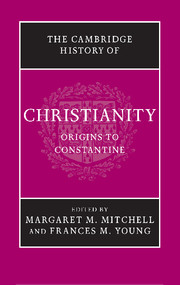Book contents
- Frontmatter
- Prelude: Jesus Christ, foundation of Christianity
- Part I The Political, Social and Religious Setting
- Part II The Jesus Movements
- Part III Community Traditions and Self-Definition
- Part IV Regional Varieties of Christianity in the First Three Centuries
- 15 From Jerusalem to the ends of the earth
- 16 Overview: the geographical spread of Christianity
- 17 Asia Minor and Achaea
- 18 Egypt
- 19 Syria and Mesopotamia
- 20 Gaul
- 21 North Africa
- 22 Rome
- Part V The Shaping of Christian Theology
- Part VI ‘Aliens’ become Citizens: towards Imperial Patronage
- Conclusion: retrospect and prospect
- Bibliographies
- Index
- Map 1. The Roman Empire in the time of Marcus Aurelius
- References
22 - Rome
from Part IV - Regional Varieties of Christianity in the First Three Centuries
Published online by Cambridge University Press: 28 March 2008
- Frontmatter
- Prelude: Jesus Christ, foundation of Christianity
- Part I The Political, Social and Religious Setting
- Part II The Jesus Movements
- Part III Community Traditions and Self-Definition
- Part IV Regional Varieties of Christianity in the First Three Centuries
- 15 From Jerusalem to the ends of the earth
- 16 Overview: the geographical spread of Christianity
- 17 Asia Minor and Achaea
- 18 Egypt
- 19 Syria and Mesopotamia
- 20 Gaul
- 21 North Africa
- 22 Rome
- Part V The Shaping of Christian Theology
- Part VI ‘Aliens’ become Citizens: towards Imperial Patronage
- Conclusion: retrospect and prospect
- Bibliographies
- Index
- Map 1. The Roman Empire in the time of Marcus Aurelius
- References
Summary
All roads lead to Rome. The perspective adopted here is that Rome absorbed many cross-currents from around the early Christian world, and, far from itself generating or disseminating a specific theology, the Roman church was fragmented and subject to repeated internal upheavals in the first three centuries. Time and again, this church found itself affected by controversies imported by immigrants from around the empire. This seems, generally speaking, a truer characterisation than Walter Bauer’s much discussed thesis that originally heretical forms of Christianity else where were brought into line by Rome seeking to impose its authority on other Christian communities.
The evidence
Evidence for the ancient city of Rome itself, its history and society, is far too extensive to detail here. Christians had little impact on the city’s life or monumental architecture prior to the major building programme undertaken by Constantine.
For Christianity in Rome there are literary sources, both Christian and non-Christian, and material evidence of various types.
Keywords
- Type
- Chapter
- Information
- The Cambridge History of Christianity , pp. 397 - 412Publisher: Cambridge University PressPrint publication year: 2006
References
- 4
- Cited by

